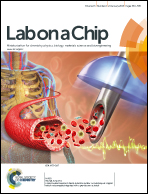Efficient single-cell poration by microsecond laser pulses†
Abstract
Payloads including FITC-Dextran dye and plasmids were delivered into NIH/3T3 fibroblasts using microbubbles produced by microsecond laser pulses to induce pores in the cell membranes. Two different operational modes were used to achieve molecular delivery. Smaller molecules, such as the FITC-Dextran dye, were delivered via a scanning-laser mode. The poration efficiency and the cell viability were both 95.1 ± 3.0%. Relatively larger GFP plasmids can be delivered efficiently via a fixed-laser mode, which is a more vigorous method that can create larger transient pores in the cell membrane. The transfection efficiency of 5.7 kb GFP plasmid DNA can reach to 86.7 ± 3.3%. Using this cell poration system, targeted single cells can be porated with high resolution, and cells can be porated in arbitrary patterns.


 Please wait while we load your content...
Please wait while we load your content...